2006 Easter Weekend in Looe
After last year’s rather abortive attempt to have an Easter diving trip to Looe (blown out after the first day’s dives) it seemed a rather dodgy proposition to have another go, but after a winter with only the week in Egypt to light the diving darkness of Stoney cove training trips it seemed a worthwhile gamble. We assembled on Friday at the Looe Divers centre on Marine drive overlooking Looe bay and got set up for the first day on their hardboat – Morning Glory – a huge offshore 125. First dive was a little ambitious – the wreck of the Rosehill at 30m. As only three of us were there for the first day we dived as a threesome following a shot to the centre of the wreck. The Rosehill is a pretty classic steamship wreck – basically a junkyard surrounding a the pair of large round boilers which are the size of small houses and populated by congers. At least this is the kind of thing most people seem to think. I swum around the wreck with Sue and Andy happily spotting the rear deck gun, the propeller, several winches, the one remaining piston and acres of plating whilst they saw the same things and just labeled them as junk! Maybe it was because of the vis…. (4m). The Rosehill has a lot of life on it as one would expect for such a mature site (the ship was sunk by a U boat in 1917 on its way to Cardiff). Particularly visible are huge numbers of pink sea fans and red fingers – these soft corals tend to thrive in Cornwall. We called it a day at 30 minutes and came up via my DSMB. Didn’t see the 1m starfish that John Waterhouse and I swear we saw last year though …….

Smallish starfish on the Rosehill
Got rather chilly between dives as the weather was pretty windy, despite the free hot chocolate offered by the skipper and his mate but managed to warm up enough for a second dive on HMS Scylla. This has only been on the bottom for three years and I’ve managed to dive it at least once every year so far. When first I dived it there was still white paint everywhere, and signs telling dives to check their air and warning of the danger of wreck penetration. There was even an advert for PADI wreck diving courses…. Now the Scylla feels much more like a ‘real’ wreck. The paint has mostly gone and the signs are covered up by marine life. The seaward side (starboard) of the wreck is absolutely covered with plumose anenomes whilst the landward side is quite clear. There was a lot o silt around on the surfaces of the wreck – apparently the result of dredging somewhere nearby. We entered the wreck at deck level below the bridge and swum into an empty room, its adjoining toilet and then back out onto the deck. Vis was actually better inside than out in fact. There are a lot more fish on the wreck this year than last – saw several very large wrasse and a couple of big saithe. In addition to the indigenous life there were also about 100 divers (based on the number of dive boats hanging about above). After our ascent via the fixed shot buoy we had to wait in a queue for our boat to pick us up.

Funnels of the Scylla
Everyone was pretty chilly after this day’s diving so we all gathered for dinner at one of Looe’s two curry houses much to James Waterhouse’s delight.
Day two dawned and the rest of the group arrived for our first day of RIB diving. Weather was a little warmer today which was just as well since John Beer, Andy Cowan and Sarah Waterhouse were all diving in wetsuits. First dive was the Scylla again with slightly better vis than the day before. Sue and Andy had a rather short dive after her mask failed and she swalloed rather a lot of seawater. The Waterhouse family disappeared inside the wreck and were later spotted threading themselves out of the forward hatch whilst John Beer and I made our way via the gallery to the helicopter deck. We then came back to the foredeck via the funnels and the bridge which we entered via a hole in the top. In theory there is a good view of the missile launchers from there but not that day.

A proper dive boat (!)
Second dive was the James Eagan Lane which was again a rather busy site. We dropped via a fixed shot to the stern section of the wreck which is totally covered in plumose anenomes but has lots of very recognizable cogs and gears from the steering system visible. We swum about the wreckage and John Beer found the main body of the ship so three of us (Myself, John Beer and Andy Cowan) swum gently up the length of the ship over the remains of her boilers – bun dles of pipes, and onto the intact front section which is very heavily populated by marine life. Andy and John were getting a bit chilly as we crossed this section but we pressed on and found our way to the bows where a bunch of other divers were conducting stops (the bow is at 6m). Two rebreather divers were hanging about here as well which gave me something to look at during the 3 minute stop we did. One again we had a wait for our boat to pick us up as there were at least 8 RIBs here and they look pretty similar from a distance.
Last day started with a dive on Udder Rock – a pinnacle reef to the west of Looe. This was a lovely site, classic Cornwall granite reef with heaps of deadmans fingers and jewel anenomes. We saw several dogfish hanging about and swimming lazily by. The dive was theoretically a drift but in fact the current was relatively weak. This was just as well as mu reel lost it’s cable guide as I launched the DSMB which made it a pain to hold together for the rest of the dive. this, coupled with my suit leaking for most of the trip made it a less than ideal experience. Despite this hardship we had a 36 minute dive and enjoyed the sight of the cliffs and boulders sheltering juvenile Pollock.


Plumose Anemone on the Scylla Sleeping Dogfish on the Kanteong
We headed onto Fowey for lunch where I managed to empty some of the water out from my suit in the gents. Good Cornish pasties helped us warm up ready for the last dive which was on a the wreck of the Kanteong. This was to have been the worlds largest tin dredger and was on it’s maiden voyage being towed out to Asia when it turned turtle and subsequently sank just off Fowey. John Waterhouse and I joined up with a PADI instructor to dive this as a threesome. It’s a good job this chap was with some competent BSAC divers as he’d forgotten to fit his suit inflator (John fixed this halfway down the shot). We reached the bottom next to something looking like a set of very large (1.5m) soup bowls, linked to a chain running along the bottom. This was once the dredger’s bucket chain now lying on it’s side having detached from the main body of the wreck. The top was home to several sleeping dogfish and a lot of Whiting were shelting beneath the large ‘bobbin’ at the end of the chain. We swum round the structure following the PADI diver who was a bit of a torpedo and never really bothered with anything like buddy checks or signals underwater…. He often disappeared into the greenish haze whilst I and John tried to keep up. Next to the chain was a large open gridwork structure which I can’t really place on the dredger – possibly some kind of crane ? I hit the limits of the air, having only gone in with 1500 litres in my main tank and we headed back to the shot for an easy ascent. Nice last dive – will definitely try to do this one again some time. After last year’s rather abortive attempt to have an Easter diving trip to Looe (blown out after the first day’s dives) it seemed a rather dodgy proposition to have another go, but after a winter with only the week in Egypt to light the diving darkness of Stoney cove training trips it seemed a worthwhile gamble. We assembled on Friday at the Looe Divers centre on Marine drive overlooking Looe bay and got set up for the first day on their hardboat – Morning Glory – a huge offshore 125. First dive was a little ambitious – the wreck of the Rosehill at 30m. As only three of us were there for the first day we dived as a threesome following a shot to the centre of the wreck. The Rosehill is a pretty classic steamship wreck – basically a junkyard surrounding a the pair of large round boilers which are the size of small houses and populated by congers. At least this is the kind of thing most people seem to think. I swum around the wreck with Sue and Andy happily spotting the rear deck gun, the propeller, several winches, the one remaining piston and acres of plating whilst they saw the same things and just labeled them as junk! Maybe it was because of the vis…. (4m). The Rosehill has a lot of life on it as one would expect for such a mature site (the ship was sunk by a U boat in 1917 on its way to Cardiff). Particularly visible are huge numbers of pink sea fans and red fingers – these soft corals tend to thrive in Cornwall. We called it a day at 30 minutes and came up via my DSMB. Didn’t see the 1m starfish that John Waterhouse and I swear we saw last year though …….
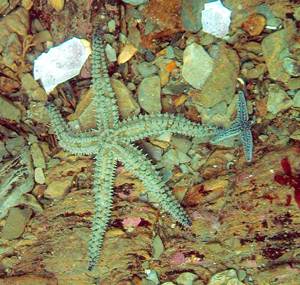
Got rather chilly between dives as the weather was pretty windy, despite the free hot chocolate offered by the skipper and his mate but managed to warm up enough for a second dive on HMS Scylla. This has only been on the bottom for three years and I’ve managed to dive it at least once every year so far. When first I dived it there was still white paint everywhere, and signs telling dives to check their air and warning of the danger of wreck penetration. There was even an advert for PADI wreck diving courses… Now the Scylla feels much more like a ‘real’ wreck. The paint has mostly gone and the signs are covered up by marine life. The seaward side (starboard) of the wreck is absolutely covered with plumose anemones whilst the landward side is quite clear. There was a lot of silt around on the surfaces of the wreck – apparently the result of dredging somewhere nearby. We entered the wreck at deck level below the bridge and swum into an empty room, its adjoining toilet and then back out onto the deck. Vis was actually better inside than out in fact. There are a lot more fish on the wreck this year than last – saw several very large wrasse and a couple of big saithe. In addition to the indigenous life, there were also about 100 divers (based on the number of dive boats hanging about above). After our ascent via the fixed shot buoy, we had to wait in a queue for our boat to pick us up.
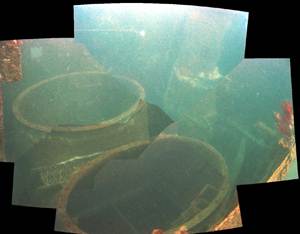
Everyone was pretty chilly after this day’s diving so we all gathered for dinner at one of Looe’s two curry houses much to James Waterhouse’s delight.
Day two dawned and the rest of the group arrived for our first day of RIB diving. The weather was a little warmer today which was just as well since John Beer, Andy Cowan and Sarah Waterhouse were all diving in wetsuits. The first dive was the Scylla again with slightly better vis than the day before. Sue and Andy had a rather short dive after her mask failed and she swallowed rather a lot of seawater. The Waterhouse family disappeared inside the wreck and were later spotted threading themselves out of the forward hatch whilst John Beer and I made our way via the gallery to the helicopter deck. We then came back to the foredeck via the funnels and the bridge which we entered via a hole in the top. In theory, there is a good view of the missile launchers from there but not that day.
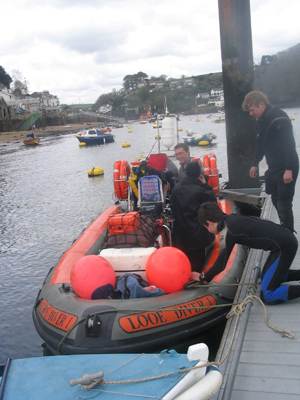
The second dive was the James Eagan Lane which was again a rather busy site. We dropped via a fixed shot to the stern section of the wreck which is totally covered in plumose anemones but has lots of very recognizable cogs and gears from the steering system visible. We swum about the wreckage and John Beer found the main body of the ship so three of us (Myself, John Beer and Andy Cowan) swum gently up the length of the ship over the remains of her boilers – bundles of pipes, and onto the intact front section which is very heavily populated by marine life. Andy and John were getting a bit chilly as we crossed this section but we pressed on and found our way to the bows where a bunch of other divers were conducting stops (the bow is at 6m). Two rebreather divers were hanging about here as well which gave me something to look at during the 3 minute stop we did. Once again we had a wait for our boat to pick us up as there were at least 8 RIBs here and they look pretty similar from a distance.
Last day started with a dive on Udder Rock – a pinnacle reef to the west of Looe. This was a lovely site, classic Cornwall granite reef with heaps of deadman’s fingers and jewel anemones. We saw several dogfish hanging about and swimming lazily by. The dive was theoretically a drift but in fact, the current was relatively weak. This was just as well as mu reel lost it’s cable guide as I launched the DSMB which made it a pain to hold together for the rest of the dive. this, coupled with my suit leaking for most of the trip made it a less than ideal experience. Despite this hardship, we had a 36-minute dive and enjoyed the sight of the cliffs and boulders sheltering juvenile Pollock.
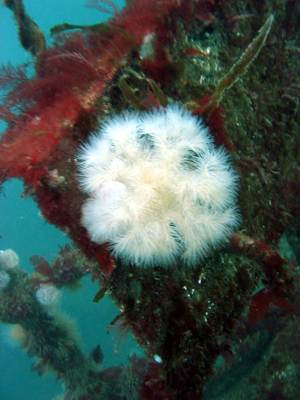
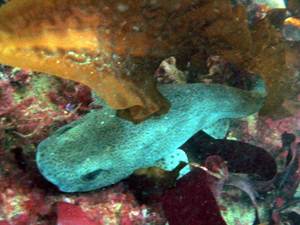
We headed to Fowey for lunch where I managed to empty some of the water out from my suit in the gents. Good Cornish pasties helped us warm up ready for the last dive which was on the wreck of the Kanteong. This was to have been the worlds largest tin dredger and was on its maiden voyage being towed out to Asia when it turned turtle and subsequently sank just off Fowey. John Waterhouse and I joined up with a PADI instructor to dive this as a threesome. It’s a good job this chap was with some competent BSAC divers as he’d forgotten to fit his suit inflator (John fixed this halfway down the shot). We reached the bottom next to something looking like a set of very large (1.5m) soup bowls, linked to a chain running along the bottom. This was once the dredger’s bucket chain now lying on its side having detached from the main body of the wreck. The top was home to several sleeping dogfish and a lot of Whiting were sheltering beneath the large ‘bobbin’ at the end of the chain. We swam round the structure following the PADI diver who was a bit of a torpedo and never really bothered with anything like buddy checks or signals underwater… He often disappeared into the greenish haze whilst I and John tried to keep up. Next to the chain was a large open gridwork structure which I can’t really place on the dredger – possibly some kind of crane? I hit the limits of the air, having only gone in with 1500 litres in my main tank and we headed back to the shot for an easy ascent. Nice last dive – will definitely try to do this one again sometime.
Pictures (top to bottom)
Smallish starfish on the Rosehill
Funnels of the Scylla
A proper dive boat (!)
Plumose Anemone on the Scylla
Sleeping Dogfish on the Kanteong
